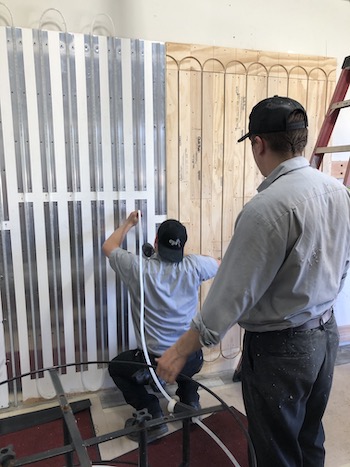BY JOHN O’REILLY
35-year industry veteran discusses why his employer, CPI Plumbing & Heating, has chosen to invest heavily in developing the tech skills of local high school grads, working with various vendors and suppliers to create a 2,500-sq.-ft. learning facility from scratch.
 The headlines tell the story with increasing urgency: The shortage of skilled workers in the trades hampers our economy. Work takes longer to complete and costs more because of inevitable delays and fierce competition. This list of reasons why this shortage has reached critical mass is as long as your arm. What isn’t as clear is what to do to correct it.
The headlines tell the story with increasing urgency: The shortage of skilled workers in the trades hampers our economy. Work takes longer to complete and costs more because of inevitable delays and fierce competition. This list of reasons why this shortage has reached critical mass is as long as your arm. What isn’t as clear is what to do to correct it.
That is, unless you’re Steve Murray, a 35-year veteran of the PHCP industry and currently HVAC Division Manager at CPI Plumbing & Heating, a full-service contractor based in Mt. Vernon, Washington, a 60-mile drive north of Seattle on Interstate 5. For Murray and CPI owners Brad Tully and Michael (Oly) Olsen, developing a team of properly trained plumbing and HVAC service technicians is a task just as important as—if not prerequisite to—successfully managing the day-to-day operations of this fast-growing company.
The key to the company’s training effort lies in its recently completed “Training Lab” where young apprentices get to practice the skills taught in the company’s classroom. To outfit the 2,500-square-foot space with the plumbing, hydronic and forced-air HVAC systems the company installs and services, CPI went to the vendors that they rely on every day.
Among the most critical was Uponor North America, because its PEX-a piping and fittings offering are at the core of the company’s plumbing and heating disciplines. Uponor responded in a big way: donating nearly $5,000 of Wirsbo hePEX plus pipe for radiant and hydronic heating applications, as well as fittings, manifolds and controls. Also included was nearly 200 linear feet of Quik Trak plywood panels, used mainly for retrofitting a residential space with radiant heating.
“The CPI Training Lab has been a significant investment for us,” says Murray. “We spent $25,000 to $30,000 outfitting the space. Thanks to Uponor and our other vendor partners, we’ve been able to get much of the material donated. But it is a serious expense, for sure—yet one that we think will pay off, long term.”
In the following interview, Murray tells how CPI ensures it has access to a ready and reliably stable of service technicians, as well as how his background positioned him to lead this important initiative for CPI.
Question (Q): How did the idea for the training room develop?
Steve Murray: The closest training center to Mt. Vernon is 50 miles away, and it isn’t practical to ask guys who have already worked a full day to drive 90 minutes in rush-hour traffic to get to a training class. While there are a few local colleges with some HVAC classes, there is nothing in plumbing. Nor did the available curriculum offer any hands-on learning, which we believed essential.
 We started by expanding an existing classroom and outfitting it with all the newest audio/visual equipment for online learning. Next, in 2018, we began to transform a junk space every contractor’s shop has into a hands-on lab where apprentices could actually practice what was taught in the classroom. We can now accommodate up to 30 students at one time. Our top techs, Coady Pike and Jake Petterson, help with the training and the curriculum planning as well.
We started by expanding an existing classroom and outfitting it with all the newest audio/visual equipment for online learning. Next, in 2018, we began to transform a junk space every contractor’s shop has into a hands-on lab where apprentices could actually practice what was taught in the classroom. We can now accommodate up to 30 students at one time. Our top techs, Coady Pike and Jake Petterson, help with the training and the curriculum planning as well.
To create an authentic environment, we framed a floor above existing plumbing connections for waste and water connections. The renovated space now has full plumbing facilities: a working bathroom, urinal and kitchen. We also have all the mechanical systems our techs work on in a home: two combi-boilers, two furnaces and air handlers, an electric furnace and, with Uponor’s help, radiant heating on the wall. We also have all kinds of water heaters, tank and tankless.
Q: What is your background and how did you gravitate to training?
Murray: After high school, I joined the Coast Guard. The trade skill in that branch of the military is called “damage control.” On a ship, damage control involves everything from firefighting, to taking care of plumbing systems, to welding and carpentry. That’s where I learned how to maintain plumbing and hydronic systems.
After five years, I left the service and got a job working for a maintenance/property management company, maintaining large apartment buildings in the older part of Seattle. From there, I worked for various contractors, becoming a journeyman plumber and HVAC service technician. Eventually, I opened my own shop for a time.
The one constant at every company, including my own, was a need for trained personnel. Most applicants lacked the necessary skills; or, worse, they had really bad habits. So, I started devising in-house training programs.
At the same time, I taught the plumbing apprenticeship track at a local trade organization called the Construction Industry Training Council. Working two jobs and commuting two hours each way for work eventually became too much. So, in 2016, I joined CPI, which is just 10 minutes from my house.
The owners wanted to grow their HVAC business, and I took on the role of HVAC Division Manager. We’re still working to grow it, and it has been a challenge, mainly because we just don’t get a lot of already properly trained candidates. That’s really what it boils down to.
Q: Who are the students and how do you find them?
Murray: Most are high school grads who CPI has hired. The average age of our apprentice crew is 20, although the average apprentice nationwide is 27, so we’re significantly below that.
Recruitment isn’t easy. Our marketing person participates in all the Chamber of Commerce meetings and all the local contractor trade groups. Last year, we started an outreach program to the local high schools, hosting meet-and-greets at the schools with graduating seniors, talking to them about the opportunities in the trades. We also host monthly open houses for interested kids and their parents. They tour the CPI Career Center and talk about what it’s like to work in the trades. That is really our best opportunity.
There is no perfect system to find the right people, and it is pretty easy to get disillusioned. So many high school guidance counselors still think every student needs to go to college to have a meaningful life. It makes no sense to me. Kids need to hear the message that the trades are a real career option that can provide a good living, post-apprenticeship training.
Q: How many young people are a part of the CPI apprenticeship program right now? What is the curriculum they follow?
Murray: Pre-COVID 19, our classes had 8 to 10 students, now it’s 3 to 5 students per session, so we can spread out.
We have done a couple of things to create the curriculum. We’ve pulled pieces together from Skill Mill (Interplay online for task-based learning), the National Center for Construction Education and Research, NATE [HVAC Courses], as well as content from the Illustrated Plumbing Manuals. I am in the classroom and can monitor what each student is learning online and can supplement that with real-world instruction on what we encounter in the field. Half a day is spent on online lessons; the other half, we’re going to the training lab to practice those skills, hands-on.
Right now, the curriculum is based on a three-month, eight-hours-a-day learning. We call it “boot camp.” Once a student graduates boot camp, he or she works in the field, side-by-side with a journeyman-level technician. Six months to a year down the road, we bring each apprentice back in for a refresher and a hands-on evaluation. There are performance tests each must pass before working independently with a customer.
Q: Do most students pick one track or another, plumbing or HVAC?
Murray: Some do both. From our perspective, it would be great if everyone did. But some lack the interest; others lack the proper skill set. Michael Olson and I are fully licensed journeyman plumbers and fully licensed HVAC technicians. We have the advantage of being able to model that opportunity for students who want to do both.
Q: What’s the advantage to CPI in developing its own young talent?
Murray: We have the confidence that the people we train know how to do things correctly. So much of what goes on in the trades is learning, one person to another. That system relies 100 percent on the person doing the training, teaching the right way to do the work. Without standardized curriculum, that is a crapshoot. The Training Lab allows us to make sure, before we send anyone into the field, they are trained to do work correctly — the way we want it done.
Q: Cynics say: Why spend the money on training, knowing that a trainee may leave and take the skills and all that investment to a competitor?
Murray: We hold ourselves to a very high standard. We want to be the best at turning out quality people. Better to train someone and run the risk of losing them, than not train them and run the risk that they will stay.



